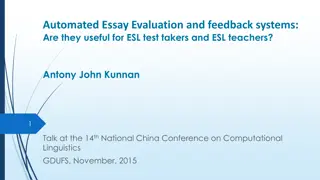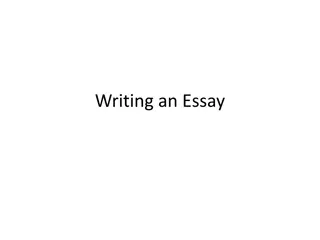Understanding the PEEL Model for Effective Essay Writing
The PEEL model, which stands for Point, Example, Explanation, Linker, is a valuable tool for incorporating quotes in essays. It helps structure your arguments by focusing on the main point, supporting it with examples, explaining their relevance, and linking ideas logically. This model is illustrated through an analysis of a character, Alex, showcasing how each component contributes to constructing a compelling argument.
Download Presentation

Please find below an Image/Link to download the presentation.
The content on the website is provided AS IS for your information and personal use only. It may not be sold, licensed, or shared on other websites without obtaining consent from the author. Download presentation by click this link. If you encounter any issues during the download, it is possible that the publisher has removed the file from their server.
E N D
Presentation Transcript
PEE(L)- model An introduction
The PEEL-model is a useful model to help you incorporate quotes in your essays. PEEL stands for: P Point E Example E Explanation L Linker
P Point oint: The point is the idea you want to prove. It may very well be a topic sentence for a paragraph, which also means that it might be the main idea of that paragraph. Alex is too young to really express his feelings about the entire situation, and instead his reactions become physical. E Example E Explanation L Linker
Alex is too young to really express his feelings about the entire situation, and instead his reactions become physical. P Point oint: E Example xample: The example is the quote(s) you then use to prove your point. This is highlighted after Alex throws up in the car: It had not been a good day. In fact, thought Alex, wiping his mouth on the the back of his hand, it had been a really bad day. (ll. 17-18) E Explanation L Linker
Alex is too young to really express his feelings about the entire situation, and instead his reactions become physical. P Point oint: E Example xample: E Explanation xplanation: : The explanation, then, examines the implicit meaning of the quote, and explains how it may be seen as proving the point. This is normally the most substantial part of the PEE(L)-model. This is highlighted after Alex throws up in the car: It had not been a good day. In fact, thought Alex, wiping his mouth on the the back of his hand, it had been a really bad day (ll. 17-18). Alex has not been capable of telling his father that he had no interest in going on the trip, and that he has been feeling guilty towards his mother all day. Not until he throws up does he even allow himself think that the day has been really bad , and even then is he still not able to voice his feelings. L Linker
Alex is too young to really express his feelings about the entire situation, and instead his reactions become physical. P Point oint: E Example xample: E Explanation xplanation: : This is highlighted after Alex throws up in the car: It had not been a good day. In fact, thought Alex, wiping his mouth on the the back of his hand, it had been a really bad day (ll. 17-18). Alex has not been capable of telling his father that he had no interest in going on the trip, and that he has been feeling guilty towards his mother all day. Not until he throws up does he even allow himself think that the day has been really bad , and even then is he still not able to voice his feelings. L Linker inker: And finally, a linker can create a bridge to the next paragraph (coherence). The same inability to communicate his feelings also becomes evident when Alex is first told about his parents divorce.
The entire paragraph thus looks as follows: Alex is too young to really express his feelings about the entire situation, and instead his reactions become physical ones. This is highlighted when Alex throws up in the car: It had not been a good day. In fact, thought Alex, wiping his mouth on the the back of his hand, it had been a really bad day (ll. 17-18). Alex has not been capable of telling his father that he had no interest in going on the trip, and that he has been feeling guilty towards his mother all day. Not until he throws up, does he even allow himself to think that the day has been really bad , and even then is he still not able to actually voice his feelings. The same inability to communicate his feelings also becomes evident when Alex is first told about his parents divorce.
TASK: Identify point, example and explanation in the following student example: Nearing the end of the story, Tom is sent to collect medicine for his father, who has forgotten to acquire it himself. This is a task that makes Tom realize that he now holds power over his father s life, similar to the way his father holds power over Tom s life by denying him access to university. His well-being depends on me now. This is why old people always say life s a funny thing. All the times he hit me and called me a nobody. And now I m the nobody he depends on. I ll get his fucking pills in my own time. (p. 4, l. 146). Tom now has power over his father in a literal way as he can choose to hurry to the pharmacy and pick up the medicine or he can choose to let time pass, potentially letting his father suffer dire consequences. Tom reflecting on the abuse he has faced at the hands of his father shows the reader that from his perspective it is a justifiable action to not hurry to the pharmacy. Tom ironically calls himself a nobody to emphasize the new change in roles as the word nobody is often used to describe a person who would not or could not do anything of importance, which is here contrasted with a very important task, that of getting the pills from the pharmacy. In this way, Tom s new situation could be viewed as a cruel twist of fate by some and justifiable karma by others as he decides to not hurry to get the pills his father needs. (student example)























